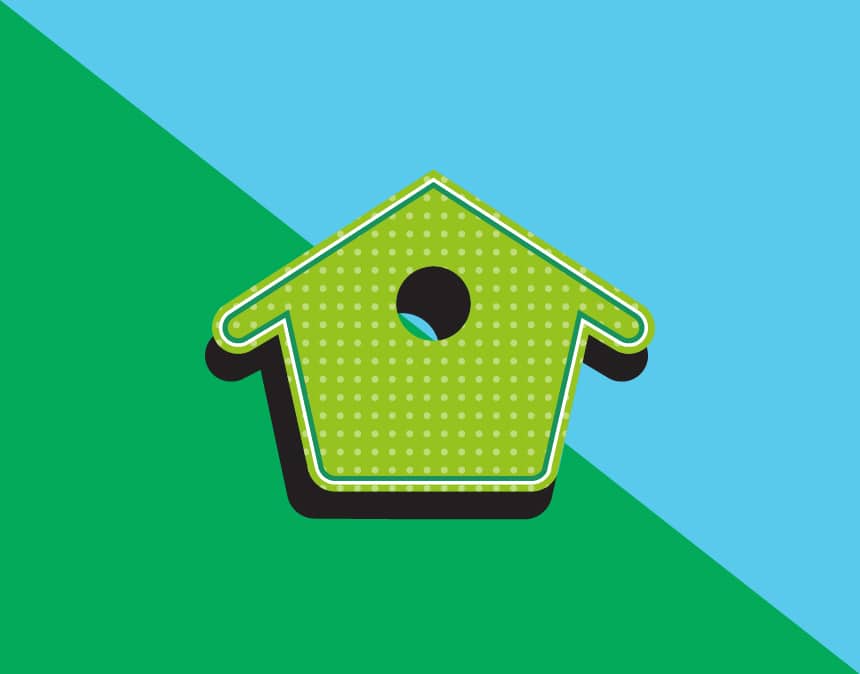Like a regular health check-up, a home maintenance schedule is important for every house’s upkeep. Continuing to check on your exterior, appliances, heating and cooling, plumbing, security, and electrical systems will help prevent breakdowns, save money, and keep your home looking its best.
For many owners, home maintenance happens only when something goes awry. Overflowing gutters, a balky furnace, or a chimney that refuses to draw provoke an expensive emergency call to service technicians. Worse, your family’s safety could be in jeopardy when key areas of your home are neglected for too long. To limit or even eliminate service delays, preserve your home’s value, and keep everyone comfortable, follow this home maintenance checklist on a regular basis.
Use all of your senses to observe. Look for texture and color changes. Look for things not level or plumb. Look for cracks, water, bugs and ants, etc. The eyes can spot much, but also pay attention to your feet. When walking, does the floor seem unstable or soft? Listen for noises or squeaks. Touch discolored areas to see if they are damp. Smell for musty odors. Does anyone start sneezing or have difficulty breathing or get a headache when in a certain area?
Check the Exterior
Interior tasks like changing air conditioner filters, painting walls, cleaning cabinets, and cleaning appliances are often easy to remember, but it’s important that you don’t forget to take care of your home’s exterior maintenance as well. Keeping up with exterior maintenance is critical to your home’s long term health. With good exterior maintenance, you can protect your home from the elements, keeping moisture, pests, rot, and decay out of your home. From inspecting your roof to patching up gaps, pressure washing your exterior, and fixing cracks in concrete, these important exterior maintenance tasks are important for keeping your home in great shape year round.
· Trim back vegetation:
Make sure that vegetation isn’t harming your home’s exterior. You’ll need to make sure tree branches aren’t hanging over your roof and damaging shingles. You should also make sure that any dense shrubs or other growth aren’t on your siding. You should keep at least a foot or two of space in between vegetation and your home.
· Fix cracks in concrete
Concrete plastering can crack and wear down over time, requiring periodic maintenance and filling in. You should fix cracks in your concrete plaster as soon as you notice them, as they are easier to repair while they are still small. Allow them to grow, and you’ll be looking at a bigger repair job, potentially one that requires professional help. You’ll also preserve the safety of walkways, which can become hazardous if cracks are present. And cracked concrete is simply unattractive, so it’s a good idea to get it fixed so your home looks better. To fix concrete cracks, you’ll need to clean them out and patch the crack with compound or caulk.
· Paint the exterior:
Keeping up with the paint on your home’s exterior will seal surfaces. This protects your home from moisture damage. You don’t necessarily have to paint every square inch, as a touch up may be all that’s needed. However, keep in mind that the color may not match up exactly. Keep an eye out for areas that frequently peel or lose paint, as this can be a sign of a moisture issue.
· Inspect and repair roof:
Your roof protects your home, but you may need to make updates to ensure it keeps protecting your home. With an exterior and interior inspection of your roof, you can find signs of defects and imperfections. These issues may let moisture, rot, even pests inside of your home and should be resolved immediately. An inspection will look for damaged or broken shingles, missing shingles, rust spots or cracked caulk on flashing, signs of decay, sagging, flashing damage, and more. Often, you can make repairs to your roof rather than completely replacing it, assuming your roof is not at the end of its expected lifespan.
· Clean your exterior door:
Your front door should be cleaned and inspected at least once a year. Use a gentle cleaner to wipe down the door. Avoid using abrasive tools that may scratch your door and do not scour or power wash the door. Simply wipe it down with wood cleaner, baby shampoo, or diluted dish soap. You’ll want to use as little water as possible and prevent water from pooling. Use a glass cleaner to wipe down glass panels.
· Clean gutters:
Gutters often get clogged with leaves, seeds, and other debris. This can lead to problems including overflow, mold, rot, pest infestations, and even flooding damage. It an also diminish the lifespan of your shingles and paint. While gutter cleaning is especially important in late fall, it is important year round to keep your drainage system working free of cloges and to avoid damage. You should also inspect your gutters for damage and sagging and repair any issues.
· Perform a chimney inspection:
Make sure that your chimney is well maintained with an inspection. You’ll want to look at exterior walls for deterioration, check that the top is sealed around the flue, and that the rain cap is installed. Make sure that protective screens are in place. There may be water damage, cracks in the masonry, or even evidence of birds or animals. These issues will need to be resolved for fire safety, moisture protection, and keeping pests out of your home.
· Clean your water Tank
We all know about the importance of clean water, yet most people forget to check up on their water tanks to make sure they’re clean because either they don’t know about the benefits of a clean water tank or they don’t make it a priority. But the fact is, having a clean tank makes the difference between healthy and drab looking skin and hair. It also helps protect you and your family from various water borne diseases. So it is not just about having clean water to drink or cook with, water that gets on your skin when you shower or in your mouth when you brush your teeth, needs to be equally clean.

· Kitchen cupboards
You probably wipe down your kitchen counters and mop your kitchen floor every day, or at least regularly. Your kitchen cabinets, on the other hand, may not get the same attention—but they should. All day they collect dirt, dust, splatters, grease, and other cooking residues; over time this mixture sticks to cabinet surfaces like a tacky glue that can be difficult to remove. Besides becoming an eyesore, unclean kitchen cabinets could pose a health risk: Bacteria like salmonella can easily contaminate cabinet handles and knobs. Grime and old food particles have no business building up inside the place where we store the items we put our food on. Your kitchen cabinets need simple, regular maintenance.
· Organize your closet
Have you ever stored clothing, just to pull it out later and have strange yellow stains on it, or notice the elastic is shot, or that pests got into them and now everything has little holes? Which means it’s time to put some waders on, dive in, and clean out your closet.
· Wood Floors
Since termites feed on wood, damage is usually most visible in places where wood is prominent. This may include termite damage to hardwood floors, wood-constructed walls, and doors. Hardwood floors may show evidence of termite damage, although the damage often is not immediately visible to homeowners. However, if the infestation is untreated for several years, the wood may become weak and give way under general use. So you should inspect your home once a year for termite infestations.
Find and Repair Hidden Plumbing Leaks
We show simple ways to find and stop common water leaks before they cause rot and other expensive damage. You’ll find most of them around bathtubs and showers, drains, sinks and toilets.Find and fix minor drips before they cause major damage.
· Under Sink Plumbing: Supply leaks
Supply leaks under the kitchen sink or bath vanity can go unnoticed for a long time since they’re usually at the back of the cabinet. Water can run down the pipes into the floor or subfloor, rotting the sink base, the floor and the framing.
· Sinks: Sink rim leaks
Sink rim leaks allow water to seep under the rim or the base of the faucet. They will gradually destroy your cabinets and countertops in kitchens and bathrooms.
· Under Sink Plumbing: Supply leaks
Supply leaks under the kitchen sink or bath vanity can go unnoticed for a long time since they’re usually at the back of the cabinet. Water can run down the pipes into the floor or subfloor, rotting the sink base, the floor and the framing.
· Sinks: Drain leaks
Drain leaks in kitchens and bathrooms usually occur at the drain or at the slip joints in the drainpipe. Hidden behind boxes and bottles, these leaks can damage flooring, cabinets and even ceilings below before you notice them.
· Adjust Your Pressure Tank
It is important to check it every so often to ensure that it is functioning properly. If the pressure goes beyond the normal pressure it may break the pipes inside the wall and create big trouble.
Follow the steps below to check and adjust pressure:
· With the pump breaker OFF, drain the tank of all water by opening a faucet in the system.
· Remove protective air valve cap. If you find that water is leaking from the valve you may have a ruptured bladder and the tank will need to be replaced.
· Check pressure in the tank with your pressure gauge.
· Release or add air as necessary to make the pressure 2 psi below the pressure switch pump cut-in setting. For example, if you have a pressure switch setting of 30/50 psi, you pressure measured at the top of the tank should read 28 psi. Air can be added with a compressor or bicycle pump.
· Replace protective air valve cap.
· Tub and shower: Splash leaks
Splash leaks are simply water escaping past a shower curtain or a shower door. Plumbers tell us it’s the most common type of bathroom leak. Although it may sound minor, this leak causes major damage when water seeps into the subfloor where flooring meets the tub or shower. Before long the vinyl flooring or tiles begin to loosen. Even worse, the plywood subfloor delaminates and rots, requiring a huge, expensive tearout and replacement project.
· Tub and shower: Drain leaks
Drain leaks allow water to sneak around the outside of the drain where it’s connected to the tub or shower. This is especially common with plastic or fiberglass tubs and shower pans, since these materials flex slightly when you stand on them, often breaking the seal around the drain. These leaks can stain or destroy the ceiling below or rot floor joists. In the case of a tub set on a concrete slab, the leak will ruin flooring in the bathroom or adjoining rooms.
· Toilet flange leaks
These leaks occur where the toilet meets the waste pipe below. They allow water to seep out at every flush, which will wreck flooring, rot the subfloor and joists, and damage the ceiling below
Electrical Appliance Maintenance
If you maintain your appliances properly, you can help extend their lifespan, improve energy efficiency and cut down on costly repair bills. But there are a lot of myths floating around about the proper way to maintain your fridge, dishwasher, oven and other kitchen appliances.
· Keep Air Filters Clean
One often overlooked aspect of home maintenance involves the house air filtration system. Dirty or clogged air filters can result in damage to air conditioning systems, or even in extreme cases, a breakdown or a fire. Filters in portable air filtration systems are also vulnerable to becoming dirty or clogged. Clean air filters can help keep pollution out of the air. Fortunately, keeping air filters clean is as easy as taking them out and either replacing them or cleaning them. Cleaning filters can be as simple as removing them and shaking them clean, while in other cases one can wash them or brush them off. It is best to clean any kind of air filter outside to keep dirt from circulating in the house. This should be done once a month.
· Ceiling Fan
How often do you do maintenance of your ceiling fans? Keeping your fans in check after every six months is important to ensure a safe experience.This ensures that you will be able to spot out any abnormalities regarding the functioning of your fans as soon as they start to creep in.Check the ceiling fan hook connected to the roof is rusted or not .You will be able to fix those problems before any fatal accidents happen.Apart from that, regular maintenance will ensure the fans well being, and increase its longevity.
· Clean Refrigerator Coils
Refrigerator condenser coils are located on the back of the fridge or across the bottom. When coils are clogged with dust, pet hair and cobwebs, they can’t efficiently release heat. The result is your compressor works harder and longer than it was designed to, using more energy and shortening the life of your fridge. Clean the coils with a coil-cleaning brush and vacuum. A coil-cleaning brush, which is bendable to fit in tight areas, does a thorough job.
· Water the inverter batteries
If you have an inverter in your house, it is very important to fill water in the batteries every few months.
Always use easily available distilled water to fill the batteries. Doing this will increase the shelf life of your batteries as well as increase its efficiency.
· washing machine
Clothes washers or washing machines should work efficiently to ensure that they don’t consume too much water or electricity. Since the appliance uses soap, it’s only natural that it builds up a film of soap residue after some time, which provides the right condition for mould and bacteria to grow. Besides wiping the moisture on the door, the schedule of repair and maintenance of home appliances should include inspecting the gap between the rubber seal on the door of front loading washing machines and removing any dirt or soap residue that is caught in the fold.
One should also remove the soap drawer from the machine and clean it thoroughly, by soaking it for a few hours in hot and soapy water, if necessary, to dislodge to build up of soap and hard water residue. Additionally, check the connector pipe every few months, making sure to clean out the sieve that filters the water before it enters the machine. Once a month, remember to drain out and clean the chamber that traps dirt, lint, hair and other particles that prevent the washing machine from working efficiently.





